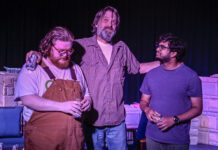Longtime OU professor, Dr. Richard Broyles, is a hunter. One of the world’s deadliest scourges, sickle cell anemia, sits squarely in his sights. He recently founded EpimedX, an Oklahoma City company that will enable him to pull the trigger. After 20 years in the blind, the geneticist and his colleagues are roughly 10 years away from firing the magic bullet that will put sickle cell anemia down once and for all.
Taking down sickle cell anemia is a lofty goal. Broyles’ goals for his cure are equally lofty and go beyond saving lives. “This will change the lives of individuals with sickle cell disease in third world countries. Children born in those countries with sickle cell anemia almost always die before they turn 5,” he says, “It’s a life or death thing for those people. In the U.S., where every baby born is tested for the disease, we’re able to identify them early. They don’t die as young, but they’ll still have serious health issues and painful lives. They’re always in crisis, in and out of emergency rooms. It’s hard for a person in that situation to get an education, much less hold a job. It’s not just a health issue.”
Broyles and his peers developed a new approach to the cure for sickle cell disease, a genetic process known as gene regulation therapy. Sickle cell anemia develops in humans with two key mutations in the genes of red blood cells. Previous attempts to cure the disease focused on changing these genes. A unique and fortuitous discovery inspired Broyles’ new technique.
In 1975, researchers discovered that certain people in Saudi Arabia had both gene mutations required for sickle cell anemia, but this population was perfectly normal. When these people were examined, researchers noticed they were still producing fetal red blood cells, the result of a second mutation in their red blood cells. Typically, as the body develops, fetal red blood cells diminish almost entirely. These people were walking around with their bloodstreams holding 35 to 45 percent of these, yet no sickle cell anemia.
It was obvious that with that many fetal red blood cells in the body, sickle cell anemia wouldn’t develop.
“That was a gold mine for scientists. We knew then that we might be able to cure sickle cell anemia without having to change its two genes. Instead, we started looking at ways to turn the genes responsible for (increased fetal blood cells) on and off and mimic nature. It turned out to be very hard to do,” he says.
Broyles and his partners are completely confident about their work, but they’re also quick to note that it will be some time before it hits the market. They still have a few hoops to jump through. Current animal trials won’t be completed for a couple of years. At the same time, they’ll be filing with the FDA for permission to begin the first human trials. That, they guess, is probably five years away. They feel good about the likely results of the human trials and expect to have their cure available within ten years.
By the time it’s implemented, Broyles’ cure for sickle cell disease will have been 30 years in the making. Twenty years ago, he and his colleagues started chasing the cure with excitement. They never lost their enthusiasm for the project.
“A lot of native curiosity helped,” he says. “It started with wondering how these genes are turned on and off in a frog and went from there. The clinical performance helped drive it even more. It’s good to have a lot of patience. In the beginning we thought this work might be useful and now there’s a high likelihood it’ll be very useful. The momentum built as we made more and more discoveries.”

























